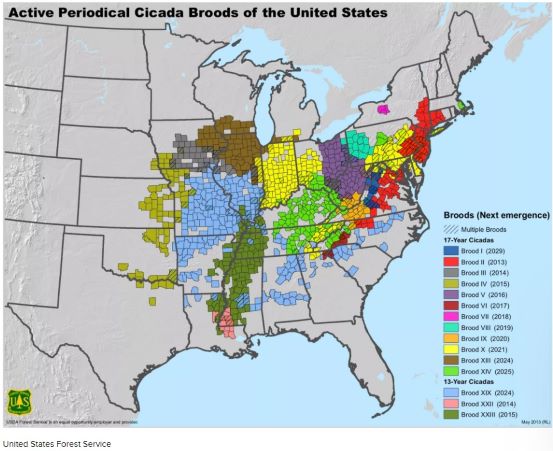(535) 素数ゼミ Periodical cicadas [調べる]
Bugging out1)
Billions of Brood X cicadas2) are expected to emerge across the eastern U.S. over the coming weeks, having last swarmed the U.S. in 2004. Much of America's cultural landscape has changed during the 17 years they spent underground feeding, but the world they find will not be wholly unfamiliar. To wit3): ーMadeleine Carlisle
2) Brood X cicadas: [brúːd] ten cicadas
3) to wit: namely, that is to say
"Sosuzemi no nazo" / Mystery of prime-numbered cicadas / by Jin Yoshimura
担当者より
アメリに、13年、あるいは17年に一度だけ何億匹も大量発生し、数週間凄い声で鳴き交わして死んでゆく、奇妙なセミがいます。この「周期ゼミ」のへんてこな暮らしの謎に、生態学者の吉村先生が進化の歴史物語からせまります。13・17の「素数」と「氷河時代」をガキに解き明かされる、壮大な進化の物語-。小さなセミに隠された生物の神秘、数字の魔法、地球の歴史まで、たくさんの不思議が好奇心をくすぐります。素敵な挿絵も満載で、子どもから大人まで楽しめる科学読み物です。(TN)
https://www.nps.gov/articles/000/cicadas-brood-x.htm
I found Yoshimura's thesis.
Abstract
The Evolutionary Origins of Periodical Cicadas During Ice Ages
J. Yoshimura
Published 1997
Biology
The American Naturalist
Periodical cicadas (Magicicada spp.4)) are known for their strikingly synchronized emergence, strong site tenacity5), and unusually long (17- and 13-yr)a life cycles for insects. Several explanattions have been proposed for the origin and maintenance of synchronization. However, no satisfactory explanations have been made for the origins of the prime-numbered life cycles. I present an evolutionary hypothesis of a forced developmental delay due to climate cooling during ice ages. Under this scenario, extremely low adult densities, caused by their extremely jong juvenile stages, selected for synchronized emergence and site tenacity because of limited mating oppoturities. The prime numbers6) (13 and 17) were selected for as life cycles because these cycles were least ikely to coemerge7), hybridize8), and break down with other synchronized cycles.
4) spp.: species
5) tenacity: the quality or state of being not easily pulled apart6) prime number: 素数、1とその数字以外に約数がない、1を除く正の整数。2・3・5・7...など無限にある。[補説]100までの素数は、2,3,5,7,11,13,17,19,23,29,31,37,41,43,47,53,59,61,67,71,73,79,83,89,97。25個ある。
6) coemerge: to emerge together
7) hybridize: を交配する
3. Brood X Periodical Cicadas FAQ
Brood X (X is 10 in Roman numerals) is the largest brood of 17-year cicadas. This brood is found in three separate areas centering around Pennsylvania and northern Verginia, Indiana, and easter Tennessee. The largest emergence of Brood X appears as adults only once every 17 years.
Q: Are they safe to be around?
Yes, they don't bite or sting.
They are not toxic to pets fin small amounts. If you have a shellfish, you may have a cicada allergy if you eat them.
Brood X (Brood 10), the Great Eastern Brood, is one of 15 broods of periodical cicadas that appear regularly throughout the eastern United States. It has the greatest range and concentration of any of the 17-yera cicadas.


I had a fun day looking for #BroodX cicadas today!!
ツイートを翻訳
*




